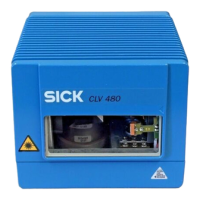Operating Instructions Chapter 8
CLV 480 Bar Code Scanner
8 010 080/O824/10-02-2005 © SICK AG · Division Auto Ident · Germany · All rights reserved 8-1
Troubleshooting
8 Troubleshooting
8.1 Overview of the possible errors and malfunctions
8.1.1 Mounting errors
• CLV aligned incorrectly with the object carrying the bar code (e. g. blanking)
• Reading pulse sensor(s) positioned incorrectly (e. g. reading interval starts too late or
stops too soon)
• Sensors for object height detection positioned incorrectly
8.1.2 Electrical installation errors
• Interfaces on the CLV connected incorrectly (wiring error in AMV/S 60)
• Host interface on AMV/S 60 configured incorrectly
8.1.3 Parameter errors
• Functions not adjusted to local conditions, e. g. communication parameters on the host
interface are set incorrectly
• Technical limits of the device exceeded, e. g. relationship between the scanning
frequency and the reading distance
8.1.4 Malfunctions
• Start/stop mode: no external reading trigger, more than one object in the reading field
• Tracking mode (with OTC 400): required minimum gap between the objects in conveyor
direction to small
• Laser timeout for incorrectly terminated reading pulse
• Device error (hardware/software)
8.2 Monitoring error and malfunctions
The CLV is self-monitoring:
• After the power supply has been switched on, the CLV automatically carries out a self-
test, in which it checks important hardware components, before it is initialized
(parameter set loaded and device functions initialized). The self-test can be repeated
at any time by cancelling Reading mode. See
Chapter 6.5.11 Self-test, Page 6-40.
• If the CLV detects an error during the self-test or at any other time, it outputs the error
status ST = 3 on the host interface. Prerequisite: the error status is enabled for trans
-
mission. This is disabled by default. The CLV displays the diagnosed error as a numeric
combination on the terminal interface (see Table 8-1, Page 8-2).
• While it is in operation, the CLV constantly monitors the laser diode and speed of the
polygon mirror wheel. In addition, a watchdog circuit responds to error statuses.
• A timer (laser timeout) automatically deactivates the laser diode in Reading mode
("Sensor input" and "Serial interface trigger" mode) if the reading interval has not ended
after 10 minutes (default setting). However, it does not end the reading interval. In this
case, the CLV outputs the message: "Laser safety timeout" on the terminal interface.
The reading interval must be terminated by resetting the trigger signal. The laser diode
is activated again by the next reading trigger.

